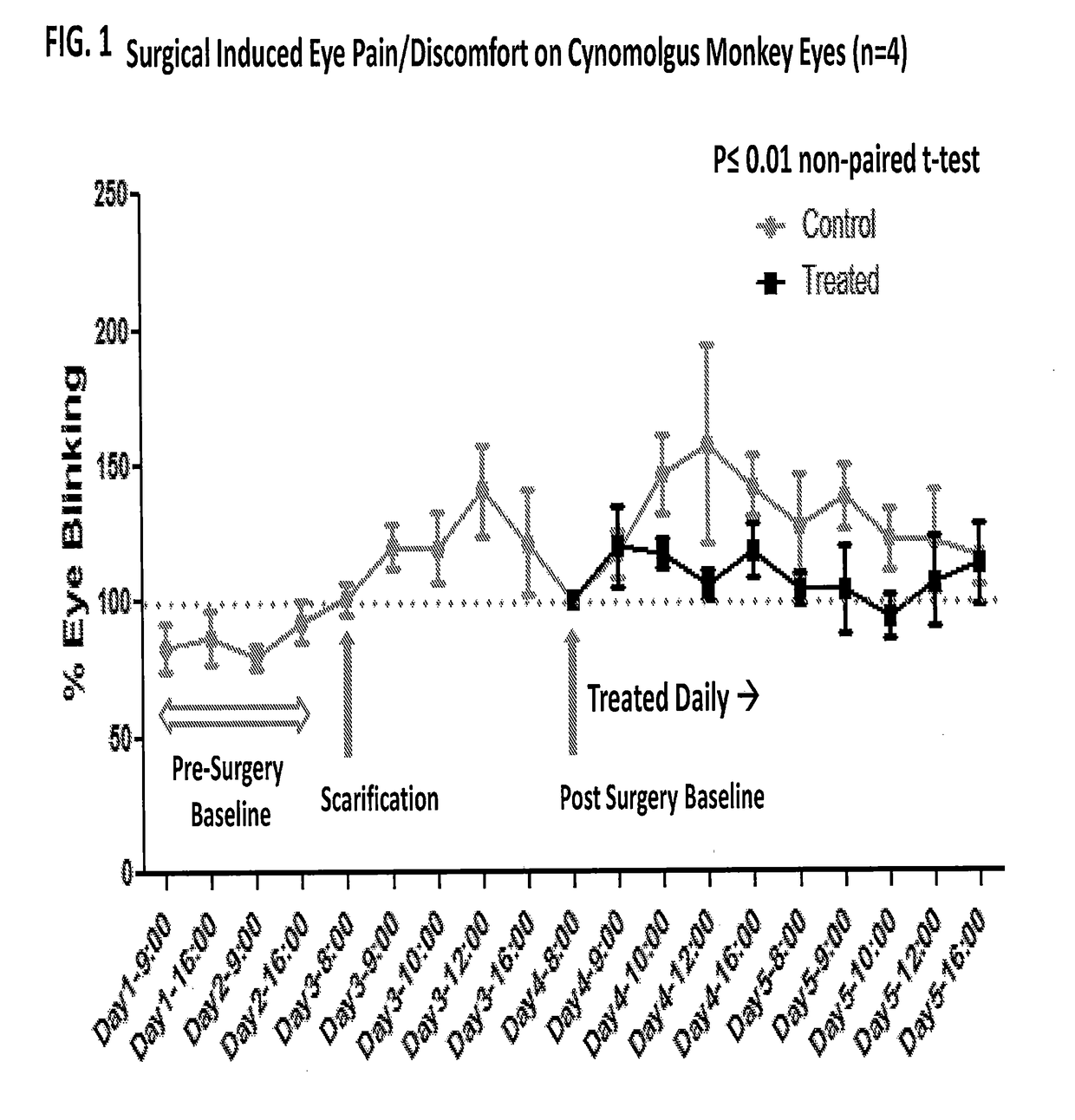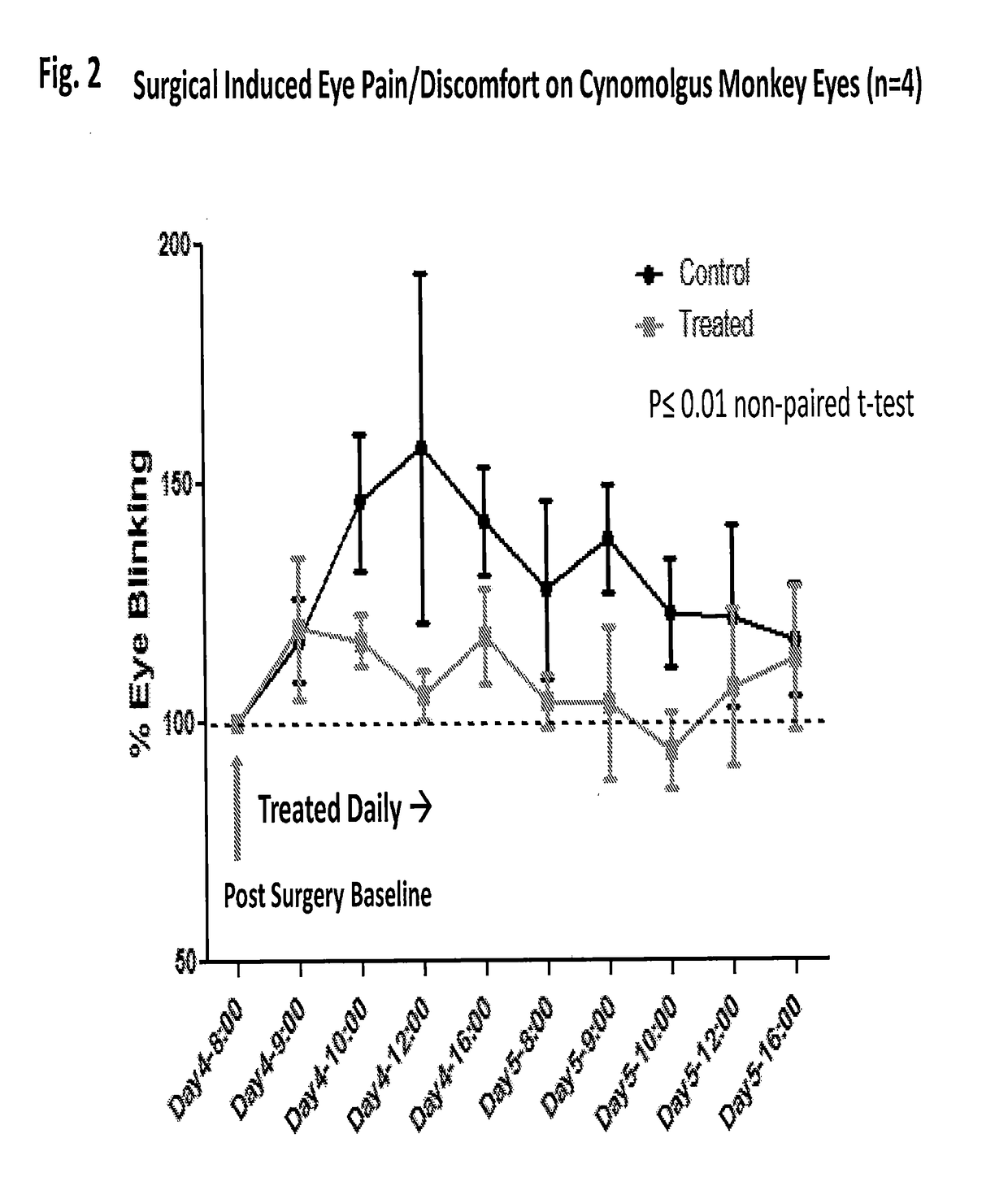Use of prostacyclin antagonists for treating ocular surface nociception
a prostacyclin and ocular surface technology, applied in the field of use of prostacyclin antagonists for treating ocular surface nociception, can solve the problems of pain and irritation, no proven therapeutic intervention available to attenuate the nociceptive stimulation and neurotransmission at the ocular surface, and less effective in reversing ongoing conditions
- Summary
- Abstract
- Description
- Claims
- Application Information
AI Technical Summary
Benefits of technology
Problems solved by technology
Method used
Image
Examples
example i
[0088]A prostanoid IP receptor antagonist (4,5-dihydro-N-[4-[[4-(1-methylethoxy)phenyl]methyl]phenyl]-1H-imadazol-2-amine RO-1138452, CAY 10441), at a dose of 0.3% w / v in an aqueous 1% polysorbate 80 in Tris-HCL (a standard ocular vehicle used in testing of ophthalmic drugs), was administered topically to the ocular surface of twelve Cynomolgus monkeys. Cynomologus monkeys are the closest animal model for humans. A model that replicates an actual clinically encountered ocular condition, namely corneal abrasion, was employed.
[0089]As an animal model indicative of both ocular discomfort and pain, mild corneal scarification and measurement of the resultant increased blinking (nictation) rate was employed. The species chosen was the Cynomologous monkey and here are reasons for this selection. The Cynomologus monkeys have similar vision to humans, its eye is structurally similar to humans, and it is the closest species phylogenetically to man. Although superior to common laboratory anima...
example ii
[0122]A 55-year old Caucasian male was suffering from extreme ocular discomfort which was associated with pain. The 55 year old Caucasian male adds a 0.3% w / v solution of 4,5-dihydro-N-[4-[[4-(1-methylethoxy)phenyl]methyl]phenyl]-1H-imadazol-2-amine and experiences an immediate reduction of ocular pain. The 55-year old Caucasian male continues to add the 0.3% w / v solution twice a day and then all pain is reduced and eventually disappears.
example iii
[0123]A 36-year old Hispanic female suffers a grade 2 chemical eye burn from an acidic substance. Despite being administered prednisolone acetate 1% every two hours, severe ocular pain persists. The physician will administer Formula 3 from Table I, three times a day. Within twelve hours of administration, the patient feels a significant reduction in ocular pain, which leads to less nictation and rubbing of her eyes and faster healing. After 7-21 days, the patient experiences corneal / conjunctival epithelium and keratocytes proliferate. Collagen synthesis begins.
PUM
| Property | Measurement | Unit |
|---|---|---|
| photosensitivity | aaaaa | aaaaa |
| ocular surface discomfort | aaaaa | aaaaa |
| chemical | aaaaa | aaaaa |
Abstract
Description
Claims
Application Information
 Login to View More
Login to View More - R&D
- Intellectual Property
- Life Sciences
- Materials
- Tech Scout
- Unparalleled Data Quality
- Higher Quality Content
- 60% Fewer Hallucinations
Browse by: Latest US Patents, China's latest patents, Technical Efficacy Thesaurus, Application Domain, Technology Topic, Popular Technical Reports.
© 2025 PatSnap. All rights reserved.Legal|Privacy policy|Modern Slavery Act Transparency Statement|Sitemap|About US| Contact US: help@patsnap.com



